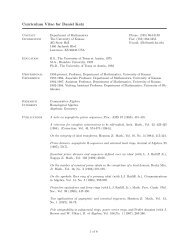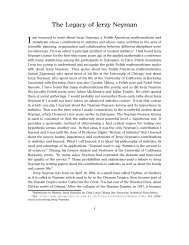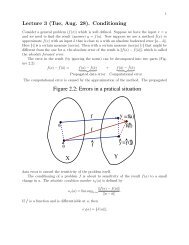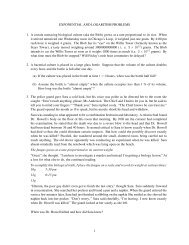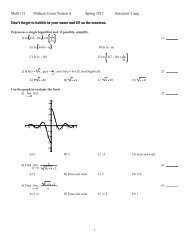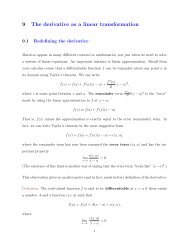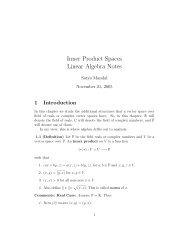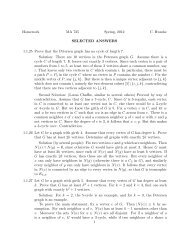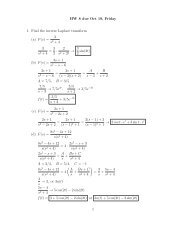Canonical Forms Linear Algebra Notes
Canonical Forms Linear Algebra Notes
Canonical Forms Linear Algebra Notes
You also want an ePaper? Increase the reach of your titles
YUMPU automatically turns print PDFs into web optimized ePapers that Google loves.
1. Let A be the matrix of T with respect to some basis E of<br />
V. We define the characteristic polynomial of T to be the<br />
characteristic polynomial of A. Note that this polynomial is<br />
well defined by the above lemma.<br />
2. We say that T is diagonalizable if the there is a basis e1, . . . , en<br />
such that each ei is a characteristic value of T. In this case,<br />
T (ei) = λiei for some λi ∈ F. Hence, with respect to this basis,<br />
the matrix of T = Diagonal(λ1, λ2, . . . , λn)<br />
Depending on how many of these eigen values λi are distinct,<br />
we can rewrite the matrix of T.<br />
3. Also note, if T is diagonilazable as above, the characteric polynomial<br />
of T = (X − λ1)(X − λ2) · · · (X − λn), which is completely<br />
factorizable.<br />
4. Suppose T is diagonalizable, as above. Depending on how<br />
many of these eigen values λi are distinct, we can rewrite the<br />
matrix of T.<br />
Now sSuppose T is diagonalizable c1, c2, . . . , cr are the distinct<br />
eigen values of T. Then the matrix of T with respect to some<br />
basis of V looks like:<br />
⎛<br />
⎜<br />
⎝<br />
c1Id1 0 · · · 0<br />
0 c2Id2 · · · 0<br />
· · · · · · · · · · · ·<br />
0 0 · · · crIdr<br />
where Ik is the identity matrix of order k. So, d1+d2+· · ·+dr =<br />
n = dim(V ).<br />
In this case, the characteristic polynomial of<br />
Further,<br />
(see 3 of 2.1.)<br />
⎞<br />
⎟<br />
⎠<br />
T = (X − c1) d1 (X − c2) d2 · · · (X − cr) dr .<br />
di = dim(N(ci)).<br />
2.7 (Read Examples) Read Example 1 and 2 in page 184<br />
4





